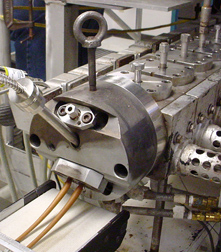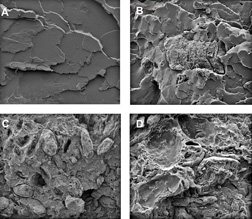Beets: A Biodegradable Bonus for Earth-Friendly Plastics?
Sugar beets supply one-third of the world’s sugar. Each year, America’s $1.27 billion sugar beet industry generates about 40 million tons of pulp—most of which is used as an inexpensive livestock feed or disposed of at cost.
But ARS scientists in Peoria, Illinois, and Wyndmoor, Pennsylvania, have teamed up on a project to breathe new economic life into the pulp. Led by ARS chemists Victoria L. Finkenstadt and LinShu Liu, the team has found a way to turn the fiber-rich pulp into a biodegradable filler material that could make polylactic acid (PLA) more cost-competitive with some petroleum-based thermoplastics, like polypropylene and polystyrene.
PLA is considered a promising natural alternative to such plastics because it is biodegradable and has comparable tensile strength and other mechanical properties. But PLA costs more because of the process by which it is obtained from fermented corn sugars.
“Use of fillers helps manufacturers cut the cost of the product,” notes Finkenstadt, who is with ARS’s National Center for Agricultural Utilization Research in Peoria. Liu is with ARS’s Eastern Regional Research Center in Wyndmoor.
Liu’s examination of sugar beet pulp showed its potential as an alternative to mineral-based fillers now used. While attending a conference 3 years ago, Liu broached the idea of collaborating with Finkenstadt, who specializes in plant polymers and is familiar with the operation of extruders and other processing equipment used at Peoria.
With technical assistance from Brian K. Jasberg, Kathy Hornback, Gary D. Grose, Richard L. Haig, Peter H. Cooke, Cheng Kung Liu, and others at both locations, Finkenstadt and LinShu Liu determined they could use sorbitol—a sugar alcohol filtered from ethanol-production waste streams—to plasticize the pulp, which reshapes its particulate matter into tendrils. Next, the pulp is mixed with melted PLA and passed through a twin-screw extruder. This results in pastalike strands of composite material, which are cooled and chopped into pellets. These are then remelted and shaped, using injection molding, into tensile bars or other forms for testing.
The team has subjected the beet-based composite material to a battery of standard industry tests to measure its tensile strength, stiffness, and durability and the force necessary to stretch and fracture it.
They’ve found that tensile strength decreases relative to increases in the amount of pulp or plasticizer added to PLA. At Wyndmoor, Liu’s group is trying to chemically modify the pulp so that its tendrils and PLA matrix form a stronger bond.
Potential uses for the new composite range from nondurable goods, such as water bottles, cups, and packaging, to lightweight indoor-construction materials, such as wallboard, tabletops, and pressed furniture.
“The idea is to tailor composite materials to have a wide range of mechanical properties,” says Finkenstadt.
Developed commercially, such composites could create new market opportunities for the U.S. sugar beet industry and improve PLA’s odds of supplanting some of today’s petrochemical plastics, whose disposal occupies 20-25 percent of landfill space.—By Jan Suszkiw, Agricultural Research Service Information Staff.
This research is part of Quality and Utilization of Agricultural Products, an ARS national program (#306) described on the World Wide Web at www.nps.ars.usda.gov.
To reach scientists mentioned in this article, contact Jan Suszkiw, USDA-ARS Information Staff, 5601 Sunnyside Ave., Beltsville, MD 20705-5129; phone (301) 504-1630, fax (301) 504-1486.
"Beets: A Biodegradable Bonus for Earth-Friendly Plastics?" was published in the March 2008 issue of Agricultural Research magazine.








